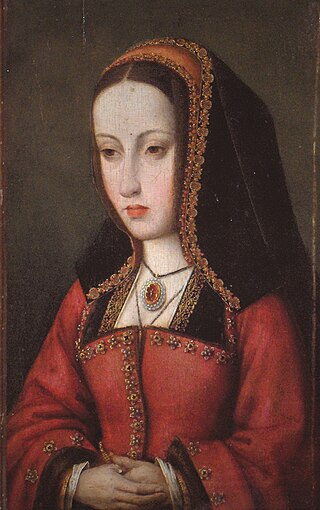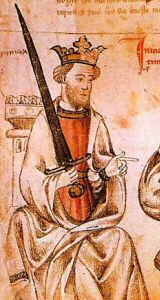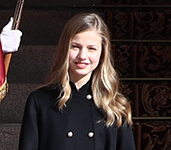
Joanna, historically known as Joanna the Mad, was the nominal Queen of Castile from 1504 and Queen of Aragon from 1516 to her death in 1555. She was married by arrangement to Philip the Handsome, Archduke of Austria, of the House of Habsburg, on 20 October 1496. Following the deaths of her brother, John, Prince of Asturias, in 1497, her elder sister Isabella in 1498, and her nephew Miguel in 1500, Joanna became the heir presumptive to the crowns of Castile and Aragon. When her mother, Queen Isabella I of Castile, died in 1504, Joanna became Queen of Castile. Her father, King Ferdinand II of Aragon, proclaimed himself Governor and Administrator of Castile.

John II of Castile was King of Castile and León from 1406 to 1454. He succeeded his older sister, Maria of Castile, Queen of Aragon, as Prince of Asturias in 1405.

Sancho IV of Castile called the Brave, was the king of Castile, León and Galicia from 1284 to his death. Following his brother Ferdinand's death, he gained the support of nobles that declared him king instead of Ferdinand's son Alfonso. Faced with revolts throughout his reign, before he died he made his wife regent for his son Ferdinand IV.

Berengaria, nicknamed the Great, was Queen of Castile for a brief time in 1217, and Queen of León from 1197 to 1204 as the second wife of King Alfonso IX. As the eldest child and heir presumptive of Alfonso VIII of Castile, she was a sought after bride, and was engaged to Conrad, the son of Holy Roman Emperor Frederick I. After Conrad's death, she married her cousin Alfonso IX of León to secure the peace between him and her father. She had five children with him before their marriage was voided by Pope Innocent III.

Prince or Princess of Asturias is the main substantive title used by the heir apparent or heir presumptive to the throne of Spain. According to the Spanish Constitution of 1978:
Article 57 [...] 2. The heir apparent or presumptive, from birth or event that makes him such, will have the dignity of Prince of Asturias and other titles traditionally linked to the successor of the Crown of Spain.

Joanna of Castile, known as la Beltraneja, was a claimant to the throne of Castile, and Queen of Portugal as the wife of King Afonso V, her uncle.
Infante, also anglicised as "infant" or translated as "prince", is the title and rank given in the Iberian kingdoms of Spain and Portugal to the sons and daughters (infantas) of the king, regardless of age, sometimes with the exception of the heir apparent or heir presumptive to the throne who usually bears a unique princely or ducal title. A woman married to a male infante was accorded the title of infanta if the marriage was dynastically approved, although since 1987 this is no longer automatically the case in Spain. Husbands of born infantas did not obtain the title of infante through marriage, although they were occasionally elevated to the title de gracia at the sovereign's command.

María de las Mercedes, Princess of Asturias was the eldest child of King Alfonso XII of Spain and his second wife, Maria Christina of Austria. She was Princess of Asturias, the heir presumptive to the Crown of Spain, for all 24 years of her life.
The Spanish royal family, a branch of the House of Bourbon, is headed by King Felipe VI.

John, Prince of Asturias and Girona, was the only son of King Ferdinand II of Aragon and Queen Isabella I of Castile, and heir apparent to both their thrones for nearly his entire life.

Leonor, Princess of Asturias is the heir presumptive to the throne of Spain as the elder daughter of King Felipe VI and Queen Letizia.

Maria of Castile was Queen of Aragon and Naples as the spouse of Alfonso V of Aragon. Maria acted as the regent of Aragon during the reign of her spouse, as he was absent during most of his reign; her regencies lasted between 1420 and 1423 and between 1432 and 1458. She was also briefly Princess of Asturias in her own right as the heir presumptive to the throne of Castile. She succeeded her father, Henry III of Castile, as Princess of Asturias in 1402.

Maria of Aragon was the Queen of Castile as the first wife of King John II from their marriage in 1420 until her death in 1445. She was the daughter of Ferdinand I of Aragon and Eleanor of Alburquerque.

Isabella I, also called Isabella the Catholic, was Queen of Castile from 1474 until her death in 1504. She was also Queen of Aragon from 1479 until her death as the wife of King Ferdinand II. Reigning together over a dynastically unified Spain, Isabella and Ferdinand are known as the Catholic Monarchs.

Princess Isabel Alfonsa of Bourbon-Two Sicilies, Infanta of Spain, was a member of the House of Bourbon-Two Sicilies and a princess of Bourbon-Two Sicilies by birth. Through her marriage to Count Jan Kanty Zamoyski, she was a member of the Zamoyski noble family and a Countess Zamoyska.

Eleanor of Castile was heir presumptive to the throne of the Crown of Castile and Princess of Asturias from 1424 until a few months before her death.
Berengaria of Castile, Infanta of Castile and Lady of Guadalajara in her own right. She was the eldest child of King Alfonso X of Castile and Violante of Aragon. She was probably named after her paternal great-grandmother, Queen Berengaria of Castile.

The Treaty of Benavente, signed on 30 December 1230, was the agreement by which Sancha and Dulce, the heiresses of the Kingdom of León, renounced their throne to their brother, King Ferdinand III of Castile, thus uniting the kingdoms of León and Castile.
















